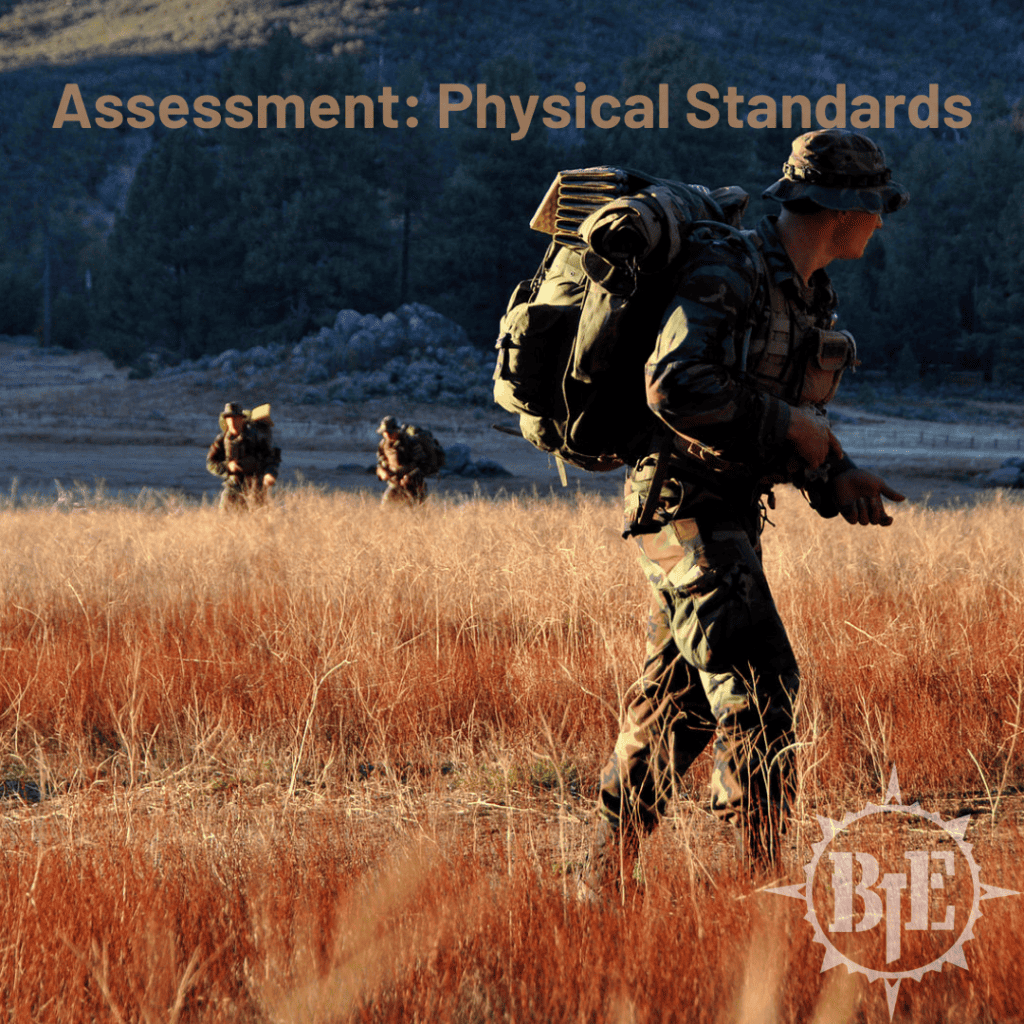“How much running, rucking, swimming, calisthenics, and strength training should I be doing to prepare for selection?”
This is one of the most common questions we get from aspiring SOF candidates, and understandably so.
Of course you’ll have to do all of these things, but the volume and intensity of each can and should vary wildly based on your strengths and weaknesses. In order to decide what your training should look like, you need an assessment process that accomplishes two things:
- Identifies areas of strength or competence (these will be the capacities you want to maintain, but won’t need improvement – at least right now)
- Identifies limiting factors (these will be the areas you emphasize during training)
These two pieces of information will dictate which areas you emphasize when building your workouts.
Now, this might seem obvious, but let’s compare this to the normal training process.
“I’ll have the usual.” The Normal Programming Process
Most coaches start with a program and then fit that program to an athlete in hopes of meeting a specific goal. The problem with this approach isn’t that it will never get the required outcome, it’s that you won’t do so reliably, efficiently, or without unconsidered consequences.
At the core of any template program is a series of assumptions, mainly that you can handle the volume, intensity, and specific modalities, and that have the requisite psychological skills and lifestyle in place to safely perform, recover from, and adapt to the work. This is why you should do a lifestyle assessment BEFORE considering what you should be doing for training.
At the end of the day, you need to be capable of achieving specific physiological outputs to pass your selection course; but the path to that end point will be different for every candidate. For example:
A really strong individual doesn’t need much strength to maintain what they have.
A really fast runner doesn’t need the same running workouts as the strong guy who hasn’t been running much.
This is obvious. But, how many of you reading this are working off templates or ignore the thing you aren’t good at? Remember: knowing a thing isn’t the same thing as consistently making it part of your behavior.
It’s not that a simple progression or general template can’t work well – it can. If you haven’t been running and need to hit a running standard, the first step is to start running with some kind of intelligent plan. In this situation, a template will work well for most people for a little while.
But, this isn’t a comprehensive approach. You should always be maintaining all physical qualities while working on plugging the holes in your fitness. We only have so much time and adaptive capacity, and making the most of both requires some strategy. This calls for a more comprehensive approach than adding more and more pieces over time or ignoring necessary aspects of your fitness to improve a glaring weakness.
You can’t start with a running program, sprinkle in some powerlifting, then add in some calisthenics, and then start rucking on your off days and finally add in some beatdown circuits. But, this is what most people do. Instead, you should be varying the volume, frequency, and intensity of each component of your program over time based on limiting factors.
Physical Profile
Before you worry about the perfect mixture of workouts, you need to run a battery of assessments to see where you are relative to the physical norms (standards) necessary to pass selection.
As we’ve discussed at length in our book and on this blog, hitting all the physical standards for SOF selection does not guarantee success – it just gives you a better shot. Mental and emotional factors play a massive role in your success, or failure.
Conditioning
The tests below are useful for developing a comprehensive profile of your conditioning status, from short-duration (power) to multi-hour endurance (extended capacity).
If you’re going to a land-based, ruck-intensive program (SFAS, RASP), the extended capacity test is extremely important, and the 400m run (power) would be the least important.
If you’ll be attending a maritime program and timed rucks won’t be a part of your selection process, you should focus on swimming and not worry about your walking-around-with-a-backpack times.
Choose the most relevant tests for your specific program in each category. If you haven’t been running or rucking close to the distances of the tests, don’t attempt them. Focus on building a foundation first and test once the distances aren’t a challenge.
| Extended Capacity | ||
| Test | Standard | Your Score |
| 8-12 mile ruck w/ 50# | 15:00 min / mile ave. pace | |
| 8+ mile run | 8:15 min / mile ave. pace | |
| Capacity | ||
| Test | Standard | Your Score |
| 4 mile ruck | 56:00 min | |
| 5 mile run | 37:30 min | |
| 2000m CSS swim (no fins) | 40:00 min | |
| Extended Power | ||
| Test | Standard | Your Score |
| 1.5 – 2 mile run | 6:30 min / mile ave. pace | |
| 500m CSS swim (no fins) | 9:00 min | |
| Power | ||
| Test | Standard | Your Score |
| 400m run | 1:05 | |
| 100m CSS swim (no fins) | 1:45 | |
Once you have your time for a test in each category, compare them to the norms and identify the specific energy systems that need the most improvement. Use the following articles to program your training:
Strength & Power
There is no strength test in a selection program. Instead, you’ll have to carry heavy rucks, boats, logs, and your fellow classmates in a variety of tasks. Bigger people have the advantage when it comes to these kinds of tasks because they don’t need as much relative strength (strength compared to your body weight) to move the same object.
But, if your relative strength is up to the standards below, you’ll be able to deal with these challenges regardless of your size.
It’s important to note that you don’t get bonus points for being stronger than necessary. As we’ve discussed throughout our book, too much of one thing often comes at a cost of another. If the strength numbers are easy for you to hit, you’re likely spending too much time lifting weights and not enough running, swimming, and/or rucking.
Based on your body type and background you may have a movement or two that you just can’t get to the standard. That’s OK. As long as it’s not a glaring weakness (not even close), it likely won’t hold you back. Focus on trends, not single data points. When testing, you don’t need to do every exercise, but do try to do at least one test for every movement pattern (e.g. do at least one squat or deadlift variation).
Power is related, but not the same as strength – this is covered in detail in Chapter 17 of our book (in the updated 2nd edition). Power standards are relatively low, and should be easily attainable if you can also hit the strength standards.
| Power | ||
| Test | Standard | Your Score |
| Broad Jump | 8 feet | |
| Vertical Jump | 25 inches | |
| Lower Body Strength | ||
| Test | Standard | Your Score |
| Trap Bar Deadlift | 2x bodyweight | |
| Front Squat | 1.5x bodyweight | |
| Back Squat | 1.75x bodyweight | |
| Straight Bar Deadlift | 1.75x bodyweight | |
| Rear Foot Elevated Split Squat | 1x Bodyweight | |
| Upper Body Strength | ||
| Test | Standard | Your Score |
| Bench Press | 1.25x bodyweight | |
| Kettlebell Overhead Press (1 arm at a time) | 45% x bodyweight (1 arm) | |
| Weighted Pull Up | 45% of bodyweight | |
Once you have your numbers for multiple movements in each category compare them to the standards. Use the following article to program your training:
Work Capacity
We measure work capacity using the types of tasks you’ll be required to do for your PT tests and job. That translates to a focus on pull-ups, pushups, and grip endurance.
To test your grip strength, we use a bodyweight hang in place of a standardized weighted carry because it’s easier to measure. Everyone has a body, and nearly everyone has access to something to hang off. Not everyone has heavy free weights available.
You’ll notice the sit-ups aren’t listed as a test; that’s because they are a waste of time to train outside of when it is absolutely necessary for a PT test.
| Work Capacity | ||
| Test | Standard | Your Score |
| Pullups | 15 | |
| Pushups | 80 | |
| Bodyweight Hang | 90 seconds | |
Once you have your numbers for each movement, compare them to the standards. Use the following article to program your training:
Putting it all together
When you have completed all the necessary tests, you’ll have your scores in each of the three categories outlined in this article. This data will help you objectively determine which areas you need to target and which areas you should be putting less emphasis on during the training process.
| Physiological Profile | ||
| Category | Sub-category | Your Score |
| Strength and Power | Power | |
| Upper Body Strength | ||
| Lower Body Strength | ||
| Work Capacity | ————- | |
| Conditioning | Extended Capacity | |
| Capacity | ||
| Extended Power | ||
| Power | ||
Wrap Up
The physical standards for SOF selection outlined above are not an exhaustive explanation of all of the specific physical capabilities and skills you’ll need for every selection. A cursory internet search will provide a more detailed overview of the specific capabilities and events you’ll face in the selection you’re preparing for. Even though these courses constantly change, the general events and capabilities needed to pass do not.
You should now know what areas to target and have the resources to start piecing together an intelligent program. For more information, check out our book, a 500+ page breakdown of the process of preparing for SOF selection.
If you’re interested in receiving training that takes all of the concepts discussed in this article into account, check out the BTE Training App.
Everything you need to improve mental & physical performance, in one place. The BTE App will deliver affordable, individualized, and comprehensive training programs.




read V1 of the BTE, fantastic, gave the book to a buddy to read, I’m not in selection, too old, but love training, and want to continue to hunt / backpack in the mountains without injury, this is what I’m finding with my current workouts, wondering if I can use your app for that purpose, all round conditioning, thank you
Yes, the app with have programs for everything from SOF prep to civilians looking to get in better shape and follow and intelligent program based on their specific strengths and weaknesses.
For the strength standards, is there a certain amount of good reps needed for each?
The strength numbers are 1-rep maxes. We usually have people work up to a 3-8 rep max for safety reasons, and then project their one rep max.